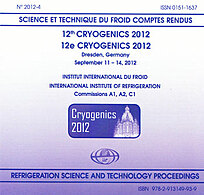
Document IIF
Évaluation de l'entreposage d'hélium brut dans des réserves en Europe ou ailleurs.
Assessment of the storage of crude helium in reserves in Europe or elswehere.
Numéro : pap. n. 059
Auteurs : CLARKE R. H., SCURLOCK R.
Résumé
Since the USA terminated its Helium Conservation Program, and started selling off its Federal Reserve helium, little action has been taken to counter the consequences to the international cryogenic industry. The Federal Reserve used to provide a “flywheel effect” which stabilised the global helium market; this stability is now lost and periodic shortages have emerged. Two issues now dominate the helium market: (1) refining capacity in the short term and (2) long term resource availability. Market modelling indicates how recurring under-supply is a serious threat to long term market sustainability. It will increasingly undermine the continuation of helium’s use, the development of new applications and the sustenance of existing ones. The obvious need to re-establish the “flywheel effect” requires the replacement of the old and depleted US reserves with additional refining capacity and a number of large scale helium storage reservoirs inside and outside the USA. This paper assesses: (1) the sourcing of crude helium, surplus to demand, for filling long-life storage reservoirs, (2) the availability of suitable geological structures in Europe and elsewhere for the long term storage of crude helium, and (3) possible ownership and financing options.
Documents disponibles
Format PDF
Pages : 296-301
Disponible
Prix public
20 €
Prix membre*
Gratuit
* meilleur tarif applicable selon le type d'adhésion (voir le détail des avantages des adhésions individuelles et collectives)
Détails
- Titre original : Assessment of the storage of crude helium in reserves in Europe or elswehere.
- Identifiant de la fiche : 30006728
- Langues : Anglais
- Source : Cryogenics 2012. Proceedings of the 12th IIR International Conference: Dresden, Germany, September 11-14, 2012.
- Date d'édition : 11/09/2012
Liens
Voir d'autres communications du même compte rendu (78)
Voir le compte rendu de la conférence
Indexation
- Thèmes : Traitement et purification des gaz
- Mots-clés : Hélium; Cryoréservoir; Algérie; Stockage; Statistique; Monde; GNL; Europe; Cryogénie
-
Low-temperature natural helium separation proce...
- Auteurs : MAKSIM K.
- Date : 15/05/2017
- Langues : Anglais
- Source : Cryogenics 2017. Proceedings of the 14th IIR International Conference: Dresden, Germany, Mai 15-19, 2017.
- Formats : PDF
Voir la fiche
-
Optimal design and operational parameter choice...
- Auteurs : BONDARENKO V. L., VIGURGINSKAÂ S. Û., SYMONENKO I. M., et al.
- Date : 07/04/2014
- Langues : Anglais
- Source : Cryogenics 2014. Proceedings of the 13th IIR International Conference: Prague, Czech Republic, April 7-11, 2014.
- Formats : PDF
Voir la fiche
-
The future of helium? A global Agency to overse...
- Auteurs : SCURLOCK R., CLARKE R. H., GLOWACKI B. A., et al.
- Date : 11/09/2012
- Langues : Anglais
- Source : Cryogenics 2012. Proceedings of the 12th IIR International Conference: Dresden, Germany, September 11-14, 2012.
- Formats : PDF
Voir la fiche
-
Energy saving technologies in installations for...
- Auteurs : BONDARENKO V. L., PODDUBNA M. V., VIHURZHINSKA S. I., et al.
- Date : 22/06/2016
- Langues : Anglais
- Source : 1st IIR International Conference of Cryogenics and Refrigeration Technology (ICCRT 2016). Proceedings: Bucharest, Romania, June 22-25, 2016.
- Formats : PDF
Voir la fiche
-
The purity of liquid helium revisited.
- Auteurs : GABAL M., SESE J., RILLO C., et al.
- Date : 15/05/2017
- Langues : Anglais
- Source : Cryogenics 2017. Proceedings of the 14th IIR International Conference: Dresden, Germany, Mai 15-19, 2017.
- Formats : PDF
Voir la fiche
